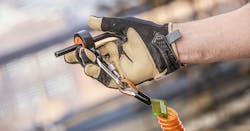ANSI/ISEA 121-2018: A Landmark in At-Heights Safety
On many worksites, tool tethering still means duct tape and twine—if anything at all. But when ANSI/ISEA 121-2018 (American National Standard for Dropped Object Prevention Solutions) launched in the summer of 2018, it not only identified dropped object prevention as a best practice, it also defined exactly what it meant (spoiler alert: duct tape and twine didn’t make the cut).
What Is ANSI/ISEA 121-2018?
Developed by the International Safety Equipment Association (ISEA) and leading safety equipment manufacturers, then adopted by the American National Standards Institute (ANSI), ANSI/ISEA 121-2018 is a voluntary consensus standard establishing minimum design, performance and labeling requirements for product solutions and guidelines for testing.
The standard is focused on four classes of preventive solutions actively used by workers to mitigate dropped objects:
Anchor attachments: Retrofit attachment points installed onto fixed anchor locations like structure or a worker themselves to anchor tool tethers.
Tool attachments: Retrofit attachment points installed onto tools and equipment, allowing them to be tethered.
Tool tethers: Lanyards that connect tools to an anchor point.
Containers: Bags and buckets that are used to transport tools and equipment to and from at-heights work zones.
The new dropped objects measure does not address things like passive preventive solutions (netting, toe boards, etc.).
Adoption and Enforcement
Quick refresher: Voluntary consensus standards for safety products are the formalization of requirements for equipment, giving manufacturers guidelines for designing and testing product. They are not directly enforceable (for either manufacturers or worksites) by regulatory bodies like OSHA.
However, standards like ANSI/ISEA 121-2018 not only guide manufacturers, workers and employers toward safer, more reliable solutions, but regulatory bodies like OSHA can reference ANSI and other consensus standards under the General Duty Clause or through a Letter of Interpretation to cite a company.
Through that lens, the new “dropped objects standard” does formalize two key points that open the door to enforcement:
1. OSHA requires employers to address falling/dropped objects on the job in both general industry (1910.23; 1910.28) and construction (1926.451; 1926.501; 1926.759) standards. This means OSHA does require that falling objects risk be addressed.
2. Prevention is a better means to addressing and mitigating those risks than protection (i.e., hard hats). One merely minimizes damage, the other prevents it completely.
Put together, these two points create the variables for OSHA to cite under the General Duty Clause, with the equipment (attachments, tethering, containers) in the new dropped objects standard being the solutions to the equation.
So, while many believe they do not have to use preventive measures like tool tethering systems on the job because there are no OSHA-specific requirements to do so, the standard can be referred to under the General Duty Clause to interpret a better way to protect workers against falling objects.
A Huge Win for Worker Safety
Gravity’s been around forever, but only now with the passing of ANSI/ISEA 121-2018 has dropped object prevention been formally recognized as a best practice and minimum requirements for those solutions agreed upon and documented.
The moment is a long time coming—years, actually—for the members of ISEA’s Dropped Object Prevention Group, chaired by Nate Bohmbach, product director, Ergodyne.
“The Dropped Object Prevention Group has worked countless hours to help save lives by creating this groundbreaking new standard. We developed it from scratch—it’s not a revision of anything—and that makes it particularly significant,” stated Bohmbach in ISEA’s official press statement at the time of the standards release in July.
Though the latest 2017 statistics from the Bureau of Labor Statistics show a slight decline in reported injuries (45,940 vs. 47,920 in 2016) and fatalities (237 vs. 255 in 2016) due to workers being struck by falling or dropped objects, there’s still plenty of work to do in educating crews on eliminating the risk. A large part of the former is convincing workers that dropped and falling objects do actually pose a risk.
“As they say on Wall Street, past performance is no guarantee of future results,” explains Bohmbach. “Drops will happen no matter how long you’ve been on the job. Just because your history is clean and clear, that alone doesn’t protect you from a future incident. Luck is bad policy.”
Greg Schrab is SVP of operations & product management with Ergodyne, a provider of safety gear and training solutions.
About the Author
Greg Schrab
SVP of operations & product management
Greg Schrab is SVP of operations & product management with Ergodyne, a provider of safety gear and training solutions.
